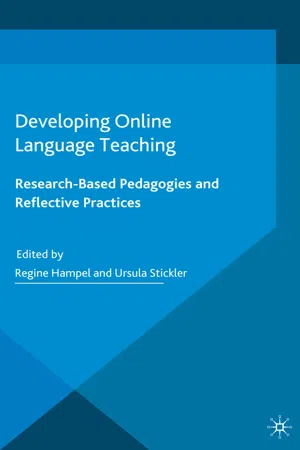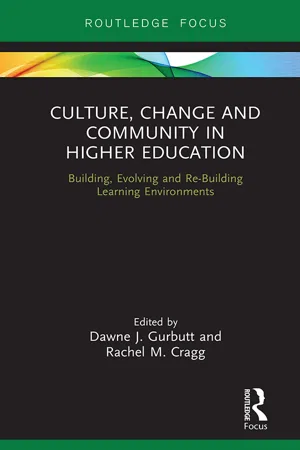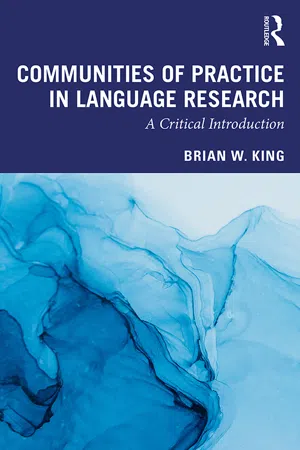Communities of Practice
Communities of Practice are groups of people who share a common interest or profession and interact regularly to learn from each other. In the field of languages and linguistics, these communities provide a space for language professionals, researchers, and enthusiasts to exchange knowledge, discuss best practices, and collaborate on language-related projects. They play a crucial role in fostering learning and professional development within the language community.
6 Key excerpts on "Communities of Practice"
- eBook - ePub
Developing Online Language Teaching
Research-Based Pedagogies and Reflective Practices
- Regine Hampel, U. Stickler, U. Stickler(Authors)
- 2015(Publication Date)
- Palgrave Macmillan(Publisher)
...(my own italics) The focus of this chapter is to define and explore three different Communities of Practice for language teachers, and to examine how these notions of ‘variety’, ‘collaboration and sharing’ and ‘power of the community’, as well as other important characteristics of these communities impact on the success of a community of practice. What are Communities of Practice? ‘They are groups of people informally bound together by shared expertise and passion for a joint enterprise’ (Wenger & Snyder, 2000, p. 139); or, as described slightly more comprehensively by Wenger (2006): ‘Communities of Practice are groups of people who share a concern or a passion for something they do and learn how to do it better as they interact regularly’ (p. 1). First introduced by Jean Lave and Etienne Wenger in the late 1980s, the term refers to the ancient concept of a ‘guild’ or ‘corporations’ of craftsmen where apprentices would learn their craft and trade by associating themselves and working for a certain period of time with experienced, skilled workers (Wenger & Snyder, 2000). Les Compagnons du tour de France in the Middle Ages (Les Compagnons du tour de France, n.d.), for instance, would execute their ‘ Tour de France ’ to work with and learn from experienced artisans to develop a mastery of their craft that would then be evidenced by their ‘ Chef d’oeuvre ’ (masterpiece). Still in existence today, 2 the Compagnonage enables a young apprentice to learn a trade from competent masters as well as from experiencing the community of a profession while living in a Compagnon house...
- eBook - ePub
The Connect Effect
Building Strong Personal, Professional, and Virtual Networks
- Michael Dulworth(Author)
- 2008(Publication Date)
- Berrett-Koehler Publishers(Publisher)
...To this day, the state representatives meet regularly, on the phone and face-to-face, as the national Interagency Transition Community of Practice. This creates a system of heterogeneous Communities of Practice at various 117 levels of scale, from the local councils to the various inter-agency communities in the participating states to the national community of state representatives. The project is part of the IDEA (Individuals with Disabilities Education Act) Partnership, which has a grant from the Education Department to support national Communities of Practice on various topics related to special education. “Communities of Practice are groups of people who share a concern, a set of problems, or a passion about a topic and who deepen their knowledge and expertise in this area by interacting on an ongoing basis,” according to Etienne Wenger, one of the leading authorities on CoPs and coauthor of Cultivating Communities of Practice: A Guide to Managing Knowledge. When I interviewed Etienne, he told me a community of practice has three core components: domain, community, and practice: The domain is the area of shared inquiry and the key issues a community of practice explores, such as childhood health, automotive engineering, or the welfare of a regional park. Because of their common interest in a domain, members of the CoP have a shared competence, even if they come from different disciplines. For example, a doctor and a teacher who are members of a CoP network whose domain is childhood health will have overlapping expertise on that topic. A community of practice is a group of people who join together to help each other solve problems and develop knowledge and expertise in an area of shared interest. 118 A CoP is a community of people, not just a collection of individuals, because they engage in joint activities and discussions, share information, and help each other...
- eBook - ePub
Culture, Change and Community in Higher Education
Building, Evolving and Re-Building Learning Environments
- Dawne J. Gurbutt, Rachel M. Cragg(Authors)
- 2019(Publication Date)
- Routledge(Publisher)
...8 Communities of Practice and continuing professional development for the real world Dawne J. Gurbutt and Rachel M. Cragg Lave and Wenger (1991) have written extensively about Communities of Practice (COP). A Community of practice is a group of people who share a craft or profession. Etienne Wenger later articulated a COP as ‘groups of people who share a concern or passion for something they do and learn how to do it better as they interact regularly.’ It is a description that could easily apply to lots of different groups within a university or within a discipline. When first conceived it was thought that Communities of Practice could not be generated but occurred naturally, but more recent views suggest that the right environment can be created for a COP to thrive, or that they can be created by putting people together. This notion of ‘situated knowledge’ has significant traction in the practice of learning and teaching and also within the professional education of those students who are ‘becoming’ a professional in a certain group. These students are learning the knowledge, skills and cultural practices of the wider group. It is a process of ‘belonging’, of generating an identity which is recognisable and valued with a group and which conveys a level of legitimacy on the individual as a member of that group. It is increasingly important for people to feel that they are connected and belong, both to the localised groups in which they work, but also to the larger community. As work becomes more technologically connected the proximity to others, to working collectively together, subtly shifts and it is more of a likelihood that individuals will become isolated and feel remote. It is interesting to note that one of the areas in which an early community of practice emerged was within an ELearning on a Master’s programme in sustainability...
- eBook - ePub
Communities of Practice in Language Research
A Critical Introduction
- Brian King(Author)
- 2019(Publication Date)
- Routledge(Publisher)
...This critique is driven by a need for emphasis on other modes of belonging besides mutual engagement that might have had (or might be having) an effect on the status of practices under observation during research (more on the details of Community of Practice in the next section). These distinctions are significant, for in discourse analysis a great deal of interpretation can depend on the notion that people in a group somehow share localised language practices (King 2014b). The CofP model can instead be framed as one way amongst many of viewing a group and its practices; that is, one way amongst many of conceiving of aggregates of people and the practices they enact during meaning making (Gee 2005a; Muehlmann 2014; Ahearn 2017). Other frameworks include communities of the imagination (Wenger 1998), communities of alignment (Wenger 1998), nexus of practices (Scollon 2001b) and publics (Coulmas 2013; Muehlmann 2014) among others that will be explored in later chapters. A given aggregate of people and their practices might be better described by some of these other models, or those people might indeed form a community of practice that is also in interaction with or nested within other types of communities such as speech communities (Creese 2005), micro-communities of knowledge (Fletcher 2014) or affinity spaces (Gee 2005b; see also Mak and Chui 2013). For these reasons, heightened vigilance is required in language research so that application of the CofP model becomes more consistently critical and sophisticated. Communities of Practice The CofP as it was first developed (Lave 1988; Lave and Wenger 1991; Wenger 1998), and as it has been interpreted for use in investigations of language in society (Eckert and McConnell-Ginet 1992, 1999; Holmes and Meyerhoff 1999), has proved to be a robust framework for the investigation of language in use...
- eBook - ePub
- Miriam Meyerhoff(Author)
- 2018(Publication Date)
- Routledge(Publisher)
...As well as providing an alternative framework for answering linguistic questions about how new linguistic forms take hold and spread in a community, the community of practice provides a framework that is well suited to more applied goals in linguistics. It is a bit of a cliché that workplaces can’t function without ‘good communication’. The community of practice framework provides a good basis for linguists to talk about what constitutes ‘good communication’ and bring some of our research out of the academy and into practical applications for training; for example, sharing ideas about what works well or what doesn’t work in achieving some jointly negotiated enterprise. exercise The importance of individual variation In Chapter 6 we saw that grouping speakers into multiple age bands is considered advantageous because it sometimes means overall trends emerge more clearly – the preferences of individual speakers won’t distract from the overall picture. But given the community of practice as an alternative level for analysis, what disadvantages might there be in grouping speakers in social classes? If large groups erase individual variation, why might this matter? This chapter will not examine studies based on Communities of Practice in detail. We will return to them in Chapter 10, where we look at how gender has been treated as a sociolinguistic variable. Some of the most systematic studies of Communities of Practice to date happen to have been undertaken by researchers interested in how society perceives and reifies gender roles. Nevertheless, it is useful to be aware of the history running from the study of speech communities to social networks and, most recently, to Communities of Practice. The rest of this chapter will focus more squarely on social network studies. It reviews the methods and the empirical insights into the nature of language variation and change that sociolinguistics has gained from them...
- eBook - ePub
- Susan Land, David Jonassen, Susan Land, David Jonassen(Authors)
- 2012(Publication Date)
- Routledge(Publisher)
...While knowledge communities can take many forms (communities of interest, knowledge-building communities, Delphi groups, etc.), Communities of Practice typically have a degree of informality (low to moderate institutionalization, making them a community and not an organization), and high connectivity (rather tight social relationships between members of the community, and a relatively high degree of identification with the group). Communities of Practice rely on situated theories of knowledge, i.e., the idea that knowledge is a property enacted by groups of people over time in shared practices, rather than the idea that knowledge is a cognitive residue in the head of an individual learner. Educators and instructional designers may capitalize on the Communities of Practice model by trying to instantiate or support communities in which desired practices reside, and allowing learners to engage through the process of legitimate peripheral participation. While no manager, teacher, or designer can create a community of practice by fiat, such communities can be supported or fostered through a variety of means, many of which involve providing technologies that support the community. Technology has affordances that allow it to represent content, scaffold processes, and shift the user's social context. These affordances can be applied to support one or more of the key aspects of the functioning of a community of practice: connections, conversations, content, and information context. References Andriessen, J. H. E. (2005). Archetypes of knowledge communities. In P. van den Besselaar, G. De Michelis, J. Preece & C. Simone (Eds.), Communities and technologies (pp. 191–213). Milan: Springer. Barab, S., & Duffy, T. (1998). From practice fields to Communities of Practice (p. 31). Bloomington, IN: Center for Research on Learning and Technology. CRLT Technical Report 1–98, http://crlt.indiana.edu/publications/duffy_publ3.pdf [accessed July 10, 2011]. Brown, J. S., & Duguid, P. (1991)...





